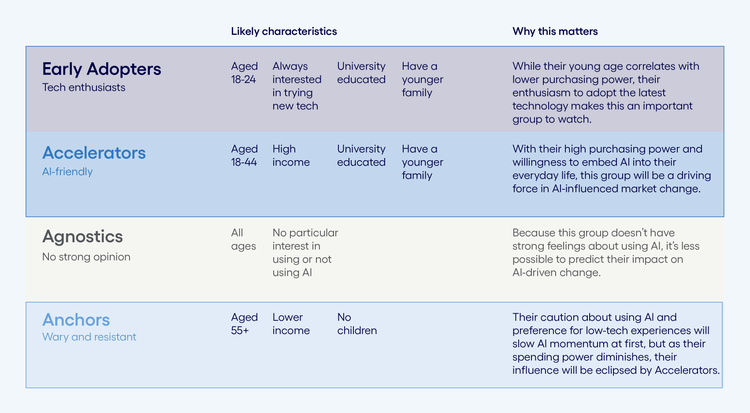

- Learn
- Buy
- Use

Learn
Consumers feel most comfortable with AI at the Learn phase, making it the first and most critical phase for businesses to focus on. Early Adopters and Accelerators have much higher scores of 58 and 50, respectively, while Anchors have a score of 33.
- Frustration with traditional search sparks a desire for convenience
- Consumers don’t always trust what’s behind AI search results
- Different consumers want different approaches to discovery

Buy
This decision-making phase is where we saw the most hesitation from consumers. Even Early Adopters and Accelerators have comparatively low scores of 34 and 33, respectively. Anchors are particularly hesitant, with a score of just 16.
- Consumers fear giving up control
- Comfort levels plummet, even for popular AI tools
- Interest is high, though, in a seamless buying experience

Use
Consumer comfort with AI rebounds in the post-sales engagement phase. This score is buoyed by Early Adopters and Accelerators, with scores of 47 and 37, respectively, but also by a strong showing from Anchors. With a score of 34, Use is where Anchors are most comfortable with AI.
- Consumers like the idea of products and services taking care of themselves
- However, they draw a line at automatic repurchasing
- Conversational AI and visual search are standouts for reliable post-sales engagement

Capturing consumers’ attention in the Learn phase will require new rules of engagement. For instance, as AI-powered tools are increasingly used to research and discover products, businesses will have to take a multimodal approach to conveying their product and service information.
Once businesses have made themselves discoverable in the Learn phase, they should move onto the Use phase, where the consumer Comfort Quotient is also high. Using AI to engage with consumers after the sale will fortify the customer relationship.
Businesses can build on that trust in the Buy phase, where they can automate purchasing but with enough user control that it encourages confidence and loyalty.
As consumer AI agents become commonplace, businesses must have AI agents ready to interoperate with their consumer counterparts. This will require new infrastructure and data capabilities.
They should also consider partnering with leading AI providers to promote products and services and collaborate on features that ensure visibility. This level of integration requires APIs that connect with external AI platforms and exchange data with consumer AI agents. Simultaneously, infrastructure investments will be needed to handle the increased data demands of interacting with these agents and platforms.
By embedding their offerings into broader AI networks, companies can maintain visibility and relevance.
For consumers, the primary driver for using AI tools is convenience—not price.
This dynamic presents a significant opportunity for businesses to attract time-starved customers with a design-for-convenience mindset. AI-powered tools are already well suited to deliver convenience and speed through hyperspecialized recommendations, instant product comparisons and quick and reliable checkout processes. New agentic capabilities will only accelerate this.
By integrating AI functionalities and agents that simplify complexities within the purchasing journey, companies can capture consumers’ interest, regardless of their existing attitudes toward AI or prior experience with the brand.
Just as consumers have grown to trust mobile interfaces for high-stakes tasks, AI will gain acceptance as it becomes accessible through a variety of familiar and reliable devices, apps and platforms.
AI capabilities should be seamlessly integrated into a variety of channels in a way that feels natural to consumers, mirroring the versatility of mobile internet access.
As consumers become more accustomed to using AI in these trusted environments, their comfort with AI-powered decision-making in other areas of their lives will likely increase. Rather than feeling forced to use it in certain contexts, consumers would likely embrace AI applications that feel like a natural extension of the tools and devices they already use.
Even consumers who are comfortable using AI still value human interaction during critical moments, especially when it comes to high-stakes purchases like healthcare or financial services.
A set-it-and-forget-it AI strategy simply won't cut it. The winning approach is a hybrid one that blends AI and human interactions. For instance, design customer experiences that incorporate AI to efficiently gather product information and make initial inquiries. Then, ensure a smooth transition to human experts for complex questions, nuanced decision-making and a personal touch just when it’s needed.
By emphasizing human oversight in their AI implementations, businesses can create customer experiences that work for a wide range of consumers and situations.
One-third of people in the world still have no access to the internet. For these marginalized populations, the transition to the agentic internet may be a leap they’re unable to make.
To avoid widening the digital divide, businesses should offer alternatives to AI experiences at key stages of the purchase journey. For example, companies could integrate interactive AI tools into their brick-and-mortar locations.
By familiarizing these groups with AI-enabled technology throughout traditional purchasing channels, businesses can ensure equal opportunity of access for all consumers until a greater level of education and democratization occurs.




